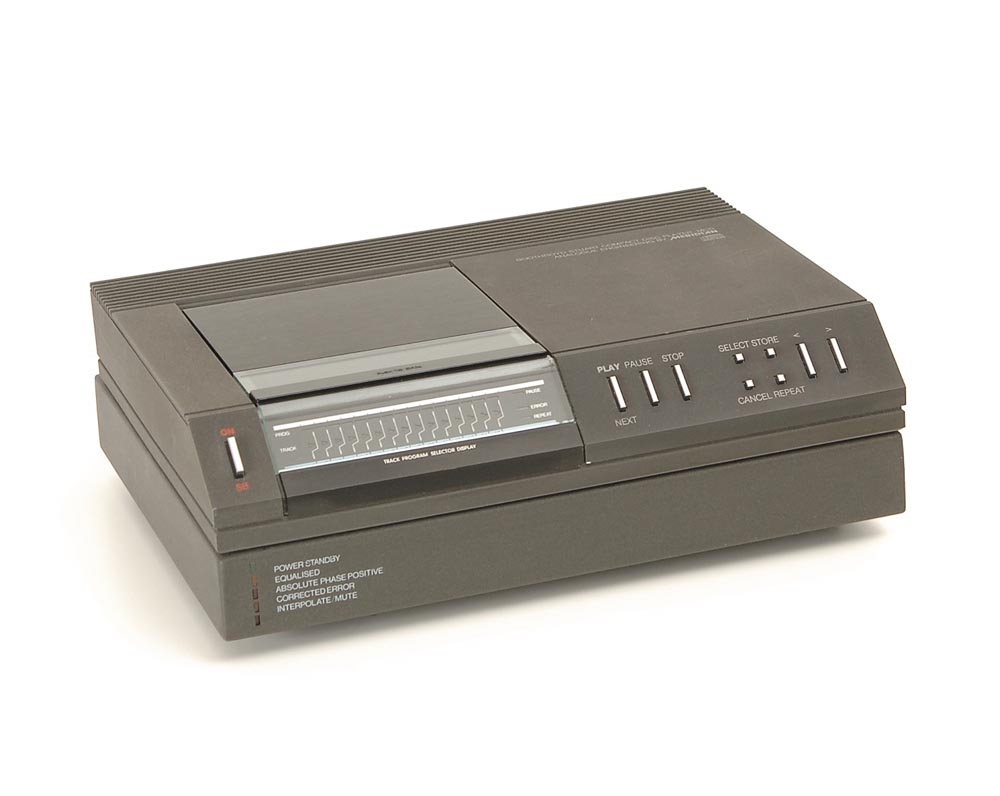Meridian has been a leader in the field of innovation since its founding in 1977. Bob Stuart and Allen Boothroyd, the company’s founders, had already worked on some of the most innovative hi-fi devices of the 1970s, including the Lecson AC1/AP1 and the Orpheus. The M1 active loudspeaker was Meridian’s bold debut when they first started out, and the stunning 100 series electronics followed soon after…
Meridian had their own preamplifier, numerous power amplifiers, and active loudspeakers by the early 1980s, and was also working on a futuristic component amplifier, which became the MCA. What it actually needed, though, was an audio source, and the new-fangled Compact Disc was ideal. Meridian was busy developing its first CD player when the technology was debuted in Japan in autumn 1982 and reached the UK in spring 1983. The MCD was the first silver disc spinner made in the United Kingdom, and it gave audiophile prestige to a format that most people were unfamiliar with at the time. “We figured we’d better get into this,” Allen Boothroyd recalls, “and we couldn’t afford to create our own laser setups, so Bob Stuart dismantled a Philips CD100 machine and determined which parts were excellent and which were not.”
“In fact, we collaborated extensively with Philips,” Bob recalls. “We were fortunate at the time because they were searching for a firm with some credibility to provide to CD, because there was a lot of gnashing of teeth when it first came out, particularly among turntable manufacturers, as you can imagine.” CD appealed to Bob because it was consistent. “Vinyl was a mess because the needle kept breaking and the discs were gritty; it never sounded right, especially near the groove’s end.” Vinyl was never natural-sounding, and it was never grounded. I knew what Compact Disc was capable of when I inspected it. We’d done a lot of work on digital before CD, so we spent a lot of time getting it to sound good, and we rapidly got to a point where we could tell the difference between different digital sources.”
The MCD was released in 1984, and it not only put Meridian on the hi-fi map, but it also put Compact Disc on it. Philips was ecstatic with the favorable feedback its format was receiving. “We didn’t do them any harm; in fact, I believe we did them a lot of good.” We had expert reviews stating that the CD was superior than the vinyl, which was significant to them. The fact that we were able to make the MCDP Pro sound so good later on was incredible for us since it really improved the brand’s perspective.”
The new player was built on the same CDM1 Pro laser transport, diecast metal chassis, and 14-bit, four-times oversampling Philips TDA1540 chipset as Philips’ first generation platform. The Meridian, on the other hand, was completely redesigned, and the result was a fantastic sounding machine that was also the best digital disc player on the market at the time.
According to Bob Stuart, “there were evident and significant architectural variations across the several platforms.” “There was a Sony/Japanese way of building a player and a Philips/European way of building a player, with the latter having oversampling. Jitter effects and power supple difficulties were uncovered, and we ventured into new territory. The Philips platform sounded so much better than the Sony system, which was profoundly defective (they sounded like a sack of nails), there was no way to cure it, and there was an engineering correctness in Philips.”
In 1985, the MCD Pro was released, which added a number of new functions and improved the sound quality even further. The original MCD cost £675 and featured beefier power supply arrangements, a low jitter master clock, absolute phase switching, error signaling, and a reworked disc clamping system with a rubber mat to dampen vibrations. It was the absolute pinnacle of the first-generation Philips machines, demonstrating the platform’s inherent correctness. It would take a long time for high-end Japanese CD players to catch up; they didn’t start accomplishing anything comparable until the early 1990s.
The MCD Pro is a tough performer even by today’s standards. It has a warm, fulsome, and spacious sound, with a beautifully solid, robust bass – no doubt thanks to its excellent conveyance – and a warm, fulsome, and expansive sound. Music has a more natural ebb and flow than many modern technology, and it flows beautifully. The player’s soundstaging has true architectural solidity, and the images are confidently located. Low-level information is lacking, though, because the MCD Pro is a 14-bit processor, which means it sounds opaque when compared to an inexpensive current system. In the end, it’s a little veiled, but that doesn’t mean it’s uninteresting to listen to. Treble is likewise limited – what’s there is silky and lovely, but it’s a little abrasive and perfunctory. Cymbals, for example, sound a touch too much like a drum machine cymbal from the 1980s. It’s a flawed treasure, to be sure, but it’s still a lot of fun.
Unfortunately, the early CDM1 Pro transports aren’t indestructible, and there aren’t any fresh replacements available. The Meridian MCD Pro will not endure indefinitely unless you have a large stock of spare first-generation machines and are ready to cannibalize them. Many are elderly enough to have passed away, while others have only a few years remaining in them. On today’s used market, they’re worth whatever someone is willing to pay for them – anywhere from £100 to £300, depending on the buyer’s luck! It was once the world’s best CD player, but today it’s a fascinating curio — a memory of hi-fi’s golden past.






